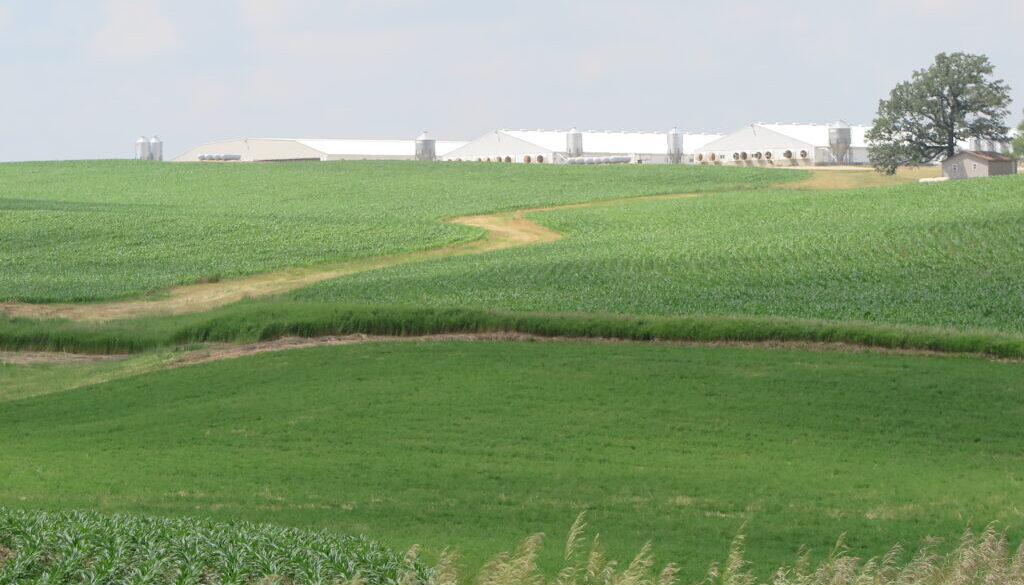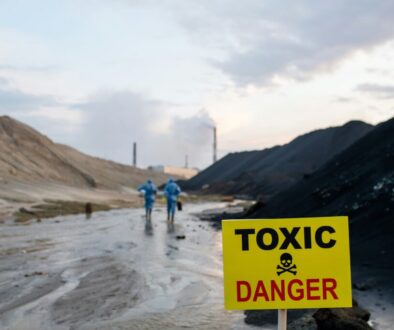Reporting project examines the scandal of US farm pollution
By Keith Schneider
There’s no way to describe farm-related nutrient pollution other than what it is – a national scandal.
A tiny minority of Americans, half of one percent, is grossly fouling the waters for tens of millions of others. Corn Belt crop farmers, and livestock and poultry producers – the heart of the rich and powerful $618 billion American farm sector – have virtually unlimited opportunities within state and federal law to pollute at will.
Crop producers, unregulated under the Clean Water Act, seek maximum production with no restriction on how much fertilizer they apply. Livestock and poultry producers, barely covered by the clean water law, treat farm fields as waste disposal zones for an ocean of untreated liquid manure and a mountain range of solid manure and poultry litter ripe with E.coli and other hazardous microorganisms. Polluting farm production practices, mostly overlooked by state environment departments, are defended by trade associations with lobbying offices in state capitals and allies from both parties in state legislatures and in Congress.
Since January I’ve been reporting the causes, consequences, and solutions to the farm sector’s assault on American waters with financial support from the Alicia Patterson Foundation, which also helped me secure a second grant from The Fund For Investigative Journalism. See the latest story here.
The project focuses on nitrate pollution in the Corn Belt and builds on expertise I gained reporting in 2022 for Circle of Blue on phosphorus pollution in Michigan and the Great Lakes states. Early reports from this year’s project have already been published in The New York Times, The Guardian, The New Lede, Circle of Blue, Minnpost, Investigate Midwest, Detroit Now, Michigan Radio, and my ModeShift blog.
To some extent, the tide of toxic nitrogen and phosphorus discharges from crop land and livestock operations is a well-recognized story not only in media, but also in government. Addressing it has resulted in an unsteady platform of responses over the last three decades held up by two of three legs.
The first is the considerable investment by states and the federal government in science. Billions of dollars have been spent on research and nutrient monitoring. America knows with great clarity the sources of nutrient contamination and the environmental, health, and economic damage it causes.
The second leg is convening. Tens of millions of dollars is spent every year to enable foundation staffs, non-profits, cities, counties, states, and the governments of the US and Canada to easily communicate with each other, hold meetings and conferences and negotiate agreements. A community of scientists, staffers, and government officers has evolved that work on nutrient contamination and have known each other for years.
Science and convening – the ironclad research and the army of experts — should set the country up to install the third leg, which is actually halting nutrient pollution. It doesn’t.
“Best management practices,” the conservation steps financed by the U.S. Department of Agriculture and many state governments, which the country relies on to deal with nutrient runoff, were really designed to halt soil erosion. They don’t work to stem the flow of nitrogen into streams and groundwater. Other practices to reduce or halt nitrogen contamination are in development and largely exist outside the agricultural mainstream.
The one sure-fire solution is to dramatically cut how much nitrogen is spread on farmland.
My reporting is devoted to discovering these and other new details that elevate the scandal of farm-related pollution to greater public attention that motivates action by regulatory agencies, courts, and state and federal lawmakers.
The reporting project examines:
- The influence of formal fertilizer recommendations by land grant universities that serve as the scientific and economic justification for encouraging crop farmers to over-fertilize
- The capacity of the American Farm Bureau and its allied farm trade associations to spend a scant amount of money on lawsuits and lobbying to defend the $618 billion farm sector from any effort to regulate nutrient discharges
- Why ever larger and polluting dairies, feedlots, and poultry houses are migrating out of Iowa and into Wisconsin, the Dakotas, Minnesota, Missouri, and Nebraska and causing fierce civic protest where they land
* Growing evidence of disease in regions where residents are exposed to nitrates in their drinking water
- The myriad practices to prevent pollution – some decades old – that either never gained traction or exist at the far edges of mainstream agriculture
The battleground is clearly defined. Opposing the powerful industrial interests are grassroots nonprofits, citizen activists, and a Native American tribe – Minnesota’s White Earth Nation – who are passing local ordinances to stem the pollution. Prominent environmental law groups are filing lawsuits and pushing the US Environmental Protection Agency to more stringently regulate farm practices that contaminate water. A handful of courageous academics are raising their voices in protest.
American agriculture is driven by inventions of engineering and science crucial to the development of the most productive farm sector on Earth. Eli Whitney invented the cotton gin in 1794 and John Deere perfected the steel plow 43 years later. German scientists Fritz Haber and Carl Bosch discovered how to convert atmospheric nitrogen into ammonia in the early 20th century. Iowa-born agronomist Norman Borlaug won the 1970 Nobel Peace Prize for developing high-yielding wheat and rice.
Effective farm practices that impede, or even eliminate, nitrate contamination have been in development for decades and merit the same level of accolades and attention. They are barely used, however, in mainstream agriculture.
Fred Blackmer’s late spring nitrate test, developed at Iowa State University in the 1980s, reduces fertilizer applications by at least half, but was never promoted by the university or commercial agriculture. The Land Institute, in Salina, Kansas, developed commercial varieties of wheat, sorghum, and rice that need to be planted just once and can be harvested year after year, like a pasture, an alfalfa field, and a Great Plains meadow, without heavy fertilizer or pesticide use. Organic and sustainable farmers rely on organic, non-chemical fertilizer to raise fruit and vegetables. Engineers have invented specialized fertilizer equipment, now in production by major implement manufacturers, that measure photosynthesis and crop growth, and apply commercial fertilizer only to individual plants that need it, sharply reducing fertilizer applications.
And yet, farm country largely shuns these advancements.
The US Department of Agriculture spends over $5 billion annually for “conservation” measures meant to reduce environmental damage from agriculture. Last summer the Biden Administration and Congress approved legislation to spend $19.5 billion for conservation programs.
That’s more than enough money to provide farmers incentives to move less-polluting production practices from the edges to the mainstream of American agriculture.
(This report, co-published with Circle of Blue, was made possible by an investigative reporting fellowship awarded by the Alicia Patterson Foundation.)
(Featured photo by Keith Schneider of a swine production operation in Minnesota. Schneider, a former New York Times national correspondent, is senior editor for Circle of Blue. He has reported on the contest for energy, food, and water in the era of climate change from six continents.)
(Opinion columns published in The New Lede represent the views of the individual(s) authoring the columns and not necessarily the perspectives of TNL editors.)



